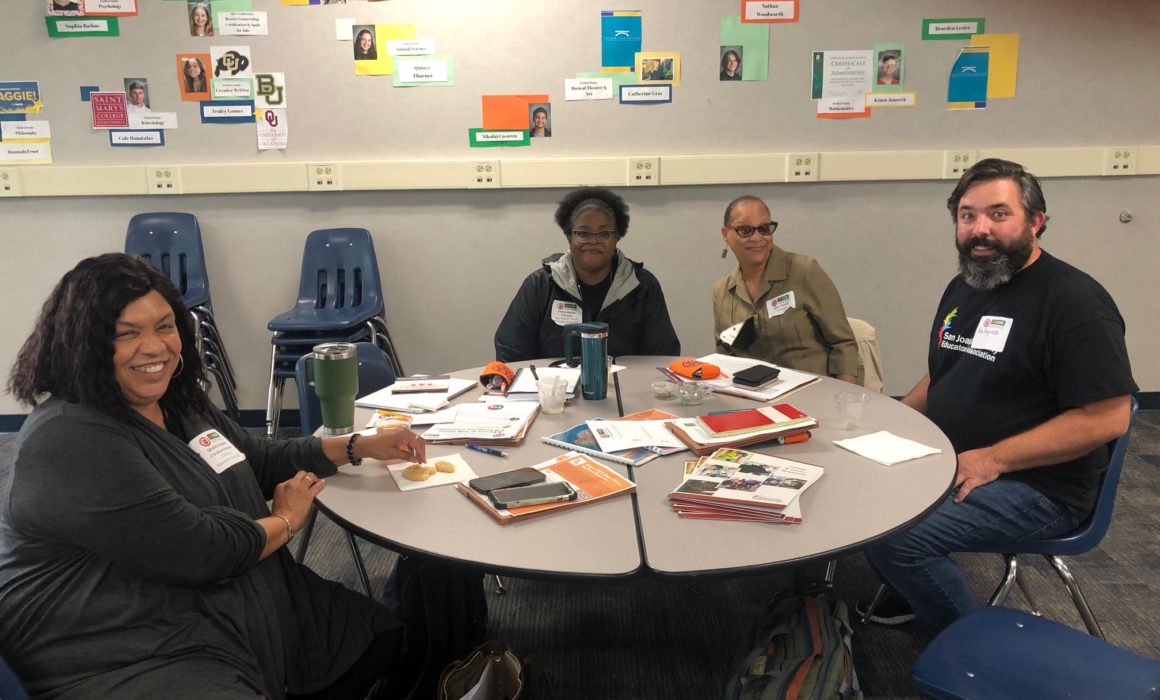
How can schools create and expand CTE programs with new state funding?
Should Career Technical Education curriculum be taught in elementary and middle schools?
Can schools make CTE programs more equitable — serving the needs of all students?
These topics and more were explored by educators committed to the future of CTE in their communities. “A Forum to Talk About CTE Program Expansion,” sponsored by the El Dorado County Leadership Academy (consisting of CTA chapter leaders from the region) coincided with the governor’s announcement to spend $1.5 billion for CTE over the next four years. The May 6 event was held at a charter school site in the El Dorado Union High School District.

Josh Keane
Attendees included members of: Black Oak Mine Teachers Association, Buckeye TA, San Joaquin County Educators Association, El Dorado Union High School District Faculty Association, Camino FA, Gold Oak TA, Placerville Elementary EA, Mother Lode TA, South Tahoe EA and the Elk Grove EA.
Some members were accompanied by their administrators and school board members. Such collaboration is necessary for high quality CTE offerings, agreed participants.
“It’s one example of how CTA is working with school leadership in multiple districts to help make CTE more accessible to all our students,” said Lance Gunnersen, a CTE woodworking and engineering teacher at El Dorado High School, who helped organize the event. “It’s great to work with other educators and administrators at all levels to provide CTE pathways to careers for students. Our job is not just sending kids to college but providing opportunities for life.”
Engaging students in CTE and career exploration at younger ages — rather than waiting until high school — was embraced by guest speakers, including Carrie Ferrero, STEAM Expo project coordinator, Nevada County Superintendent of Schools Office; Dr. Ebon Brown, assistant superintendent, Beaumont Unified; and John Merris-Coots, California Department of Education.
Tiffany Whetstone, a kindergarten teacher on special assignment at Gold Oak Elementary, enjoyed discussions about integrating CTE into existing curriculum.
“CTE in elementary school is critical in helping young students explore interests and possibilities, practice problem solving and develop skills needed to work collaboratively with their peers,” said Whetstone, Gold Oak TA.
“It can be as simple as providing science tools and natural objects for a kindergarten science center,” she added. “In transitional kindergarten, this could be a pretend animal care center that includes appropriate pictures, diagrams and tools donated from a local veterinary clinic. All the foundational skills we teach in TK through second grade can be practiced in an authentic and high-interest environment that considers and incorporates CTE.”
Josh Keane, math/science teacher at Herbert Green Middle School in Placerville, was interested in strategies to infuse CTE into middle school curriculum and has taken the lead on this at his school.
“ CTE in elementary school is critical in helping young students explore interests and possibilities, practice problem solving and develop skills needed to work collaboratively with their peers.”
— Tiffany Whetstone, Gold Oak Teachers Association

Tiffany Whetstone
“It was eye-opening to understand the importance of introducing CTE at an early age,” said the Mother Lode TA member. “Our school is implementing Project Lead the Way (a nonprofit that offers STEM K-12 curriculum) for 7th and 8th graders, so they can solve real-world problems through computer programming, construction and project implementation.
“In addition, we will incorporate the Department of Education’s California Career Resource Network, which has four assessments to help students find careers that suit their interest. Students can watch videos to explore careers and learn their economic aspects and viability.”
Wendy Lockhart, CTA’s co-consultant to the Adult, Alterative and Career Technical Education Committee, shared tips on how schools can benefit from new state funding to create comprehensive career pathways for students.
“Districts can apply to the state, or they could join together with other groups and apply,” said Lockhart, a former school board trustee for the Campbell Union High School District, where she helped start a manufacturing pathway. “But they must apply for programs designated for new
funding — in the areas of technology, health care, education and climate-related fields.”
Denise Bushnell, professor of business and innovation/entrepreneurship at Sierra College, attended remotely and encouraged coding boot camps and entrepreneurship activities for students of all ages.
The Sierra College FA member emphasized equity and the importance of CTE opportunities for all students. When some of her students lacked transportation to a makerspace site two miles away, she developed a lab on her campus that includes 3-D printers, sewing machines, welding equipment, robotics and a photography area.
Mike Patterson, CTA Board member and automotive technology teacher at South Lake Tahoe High School, said the forum increased awareness that CTE programs — and teachers — should be valued.
“We need to treat CTE teachers with respect and give them support and a livable wage,” said Patterson. “We need to create high-quality CTE facilities. When we do these things, then we can find teachers to fill these positions, despite a shortage of CTE educators.
The Discussion 0 comments Post a Comment